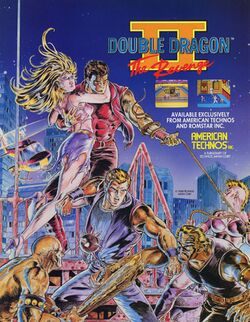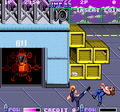
| Double Dragon II: The Revenge | |
|---|---|
| Developer(s) | Technos Japan |
| Publisher(s) | Romstar |
| Year released | 1988 |
| System(s) | Arcade, Commodore Amiga, Amstrad CPC, Commodore 64/128, DOS, Sega Genesis, Sinclair ZX Spectrum, MSX |
| Preceded by | Double Dragon |
| Followed by | Double Dragon 3: The Rosetta Stone |
| Series | Double Dragon, Arcade Archives |
| Japanese title | ダブルドラゴンⅡ ザ・リベンジ |
|---|---|
| Genre(s) | Beat 'em up |
| Players | 1-2 |
| Modes | Single player, co-op |
| Arcade Archives Double Dragon II: The Revenge | |
|---|---|
| Developer(s) | Technos Japan |
| Publisher(s) | Hamster Corporation |
| Year released | 2016 |
| System(s) | PlayStation 4, Nintendo Switch |
| Rating(s) | |
- For the NES game, see Double Dragon II: The Revenge (NES). For the Game Boy game, see Double Dragon II.
Double Dragon II: The Revenge (
-
Arcade title screen
-
Arcade game screen
Gameplay[edit]
The arcade version of Double Dragon II: The Revenge begins with Marian, the damsel in distress from the original Double Dragon, being shot to death by the leader of the Black Warriors. Once again, the players assume the role of brothers Billy and Jimmy Lee, who are now tasked with the duty of avenging Marian's death. The arcade version of the game is essentially an improved version of the original title. The biggest change in the game's controls are in the replacement of the original's punch and kick buttons with two directional-based attack buttons (Left Attack and Right Attack) similar to Renegade. Pressing the attack button of the player's current direction will do a standard series of punches, while pressing the opposite attack button will perform a back kick. A few new moves are added as well, including a Hurricane Kick.
Similar to Double Dragon, the game is divided into four areas or "missions": a heliport, a lumber storehouse, a farm, and the gang's new hideout. The player must defeat a boss at the end of each mission, as well as one or more sub-bosses along the way. Many of the enemy characters from the first game return for this one, but with altered appearances and new attacks, and the variety of weapons they use has been altered. Weapons carried by enemies include shovels, knives, chain whips, and grenades; in addition, crates, logs, and steel balls can be picked up and thrown. The enemies are as follows:
- Williams: Low-ranking member of the gang, who uses knives and shovels.
- Roper: Another low-ranking member, who can also use knives and shovels and throw crates/logs/balls.
- Linda: The only female member, who uses whips, knives, and grenades. She is the only enemy who will pick up or carry a whip.
- Oharra: A head-swap of Abobo from the first game; tall, bare-chested, with a crew cut.
- Burnov: A large man in a steel mask who is the boss of the first mission. His body vanishes when he is defeated, leaving his clothes behind. Later in the game, he gains the ability to rematerialize himself and continue fighting.
- Bolo: A head-swap of Oharra, with longer hair.
- Abore: The boss of Mission 2; a large blond man in a white shirt, red pants, and sunglasses.
- Jeff: A palette-swap of Billy and Jimmy, who can perform all of their moves.
- Chin Taimei: The boss of Mission 3; an agile martial artist who fights with kali sticks, which he never drops when knocked down.
- Willy: The leader of the Black Warriors, who uses a machine gun and never drops it when knocked down.
- Doppelganger: A shadowy clone of Billy/Jimmy that the player must fight after defeating Willy in Mission 4, as the final battle of the game. He can perform all of the player's attacks, and can also drain the player's energy if he gets close enough. If two players reach the end together, they must each face their own clone.
The player has a life meter that depletes upon being hit, and a timer runs during each mission. One life is lost if either of these reaches zero, or if the player falls off the bottom of the screen or into a pit or bed of spikes.
Ports[edit]
A console version was released for the NES on January 15, 1990, developed by Technos themselves, although it is a very distinct product from the arcade game. It was remade by Naxat Soft for the PC Engine in 1993.
Virgin Mastertronic released ports of the arcade version for the ZX Spectrum, Commodore 64, IBM PC compatibles, Amiga, Amstrad CPC, and Atari ST in 1989. The computer ports were developed by Binary Design, the same studio that handled the computer ports of the first game.
The Mega Drive version of Double Dragon II: The Revenge was released by Palsoft exclusively in Japan on December 20, 1991. Unlike the NES version, the Mega Drive version is a straight port of the original arcade game, featuring the same stages, techniques and weapons, as well as almost every enemy character, with Jeff being the lone omission. The only significant change to the level designs was in Mission 2, which was substantially changed in order to make it a longer and more complex stage. However, the characters were redesigned to much smaller proportions and are less colorful than the ones featured in the original arcade version or even the Genesis port of the original Double Dragon by Accolade released a year later in North America and Europe. The game has compatibility issues when played with a 6-button controller, suffering from slight input lag when the players move their characters with the directional pad.
An unrelated Game Boy game was released under the Double Dragon II name in North America and Europe in 1991. It was originally released in Japan in 1990 as part of the Kunio-kun series but the graphics, music, and storyline were changed for the English version of the game.
Double Dragon II was re-released in 2013 alongside the other two arcade games in a compilation titled Double Dragon Trilogy produced by DotEmu, which was released on iOS, Android and Steam platforms.
The NES version of Double Dragon II was re-released in North America as a downloadable title on all three systems available for the service: Wii, 3DS and Wii U. It was later re-released worldwide as a free downloadable title for the Nintendo Switch on June 12, 2019, provided the user has subscribed to the Nintendo Switch Online service.

